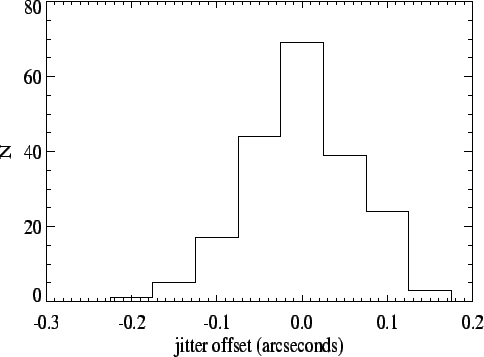




Next: 4.8 The Spectral Response
Up: 4. Calibration and Performance
Previous: 4.6 Point Spread Function
4.7 Spacecraft Pointing Jitter
The ISO pointing system is described in detail in the ISO Handbook
Volume I, [40].
It has been shown to yield the following performance:
- random motion of the satellite is 0.5
 (2
(2  ),
),
- absolute pointing drift is smaller than 0.1
 /hour,
/hour,
- absolute pointing error (blind pointing accuracy):
around 2
 (half cone).
(half cone).
This pointing stability was much better than the pre-launch
specifications of the spacecraft.
However, the random spacecraft jitter, although limited to about
0.5
 , can cause a slight displacement
of a source from image to image, which is most noticeable when a
point source is observed.
This pointing jitter
has some impact on the data analysis and in principle a correction for this
systematic effect would be desirable. So far, despite numerous attempts,
none of the proposed algorithms to correct for this effect was very
successful. Fortunately, even when using the
1.5
, can cause a slight displacement
of a source from image to image, which is most noticeable when a
point source is observed.
This pointing jitter
has some impact on the data analysis and in principle a correction for this
systematic effect would be desirable. So far, despite numerous attempts,
none of the proposed algorithms to correct for this effect was very
successful. Fortunately, even when using the
1.5
 pfov lens, the influence of the pointing jitter
is not dramatic (Figure 4.19).
More details on the jitter correction currently available in CIA
can be found in the ISOCAM Interactive Analysis User's Manual,
[28].
pfov lens, the influence of the pointing jitter
is not dramatic (Figure 4.19).
More details on the jitter correction currently available in CIA
can be found in the ISOCAM Interactive Analysis User's Manual,
[28].
Figure 4.19:
Distribution of pointing jitter offsets as computed
with a Gaussian fitting method as available in CIA. Data are taken
from observations of the calibration standard star HIC 73005. In
this particular case the pointing jitter standard deviation is
measured to be 0.065
 , a good demonstration of
the pointing stability of the ISO telescope.
, a good demonstration of
the pointing stability of the ISO telescope.
|
|





Next: 4.8 The Spectral Response
Up: 4. Calibration and Performance
Previous: 4.6 Point Spread Function
ISO Handbook Volume II (CAM), Version 2.0, SAI/1999-057/Dc
